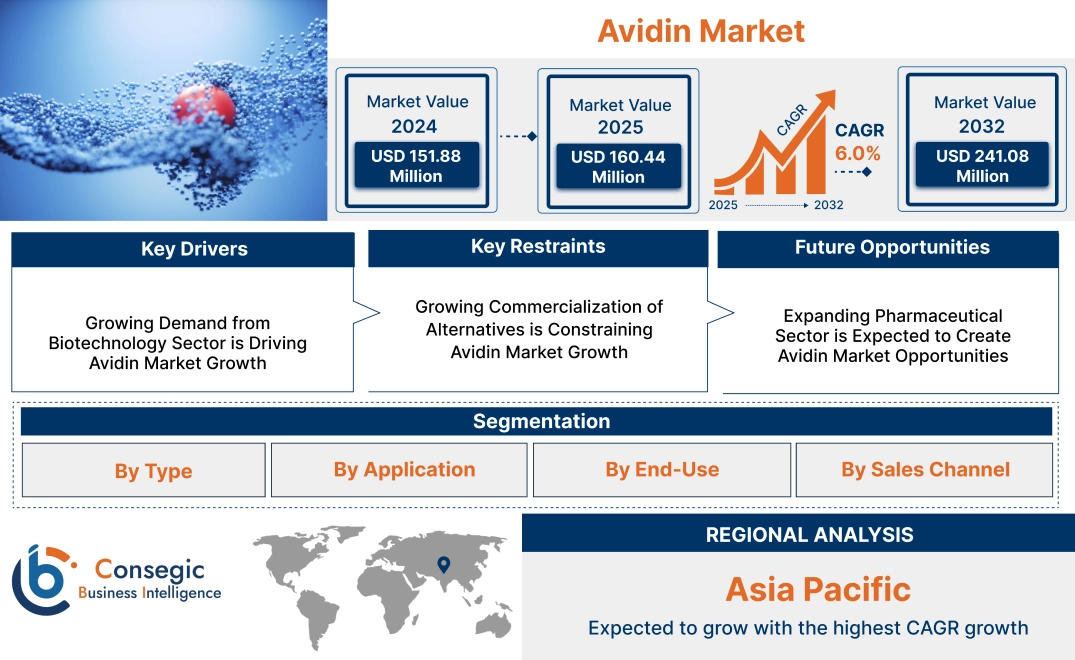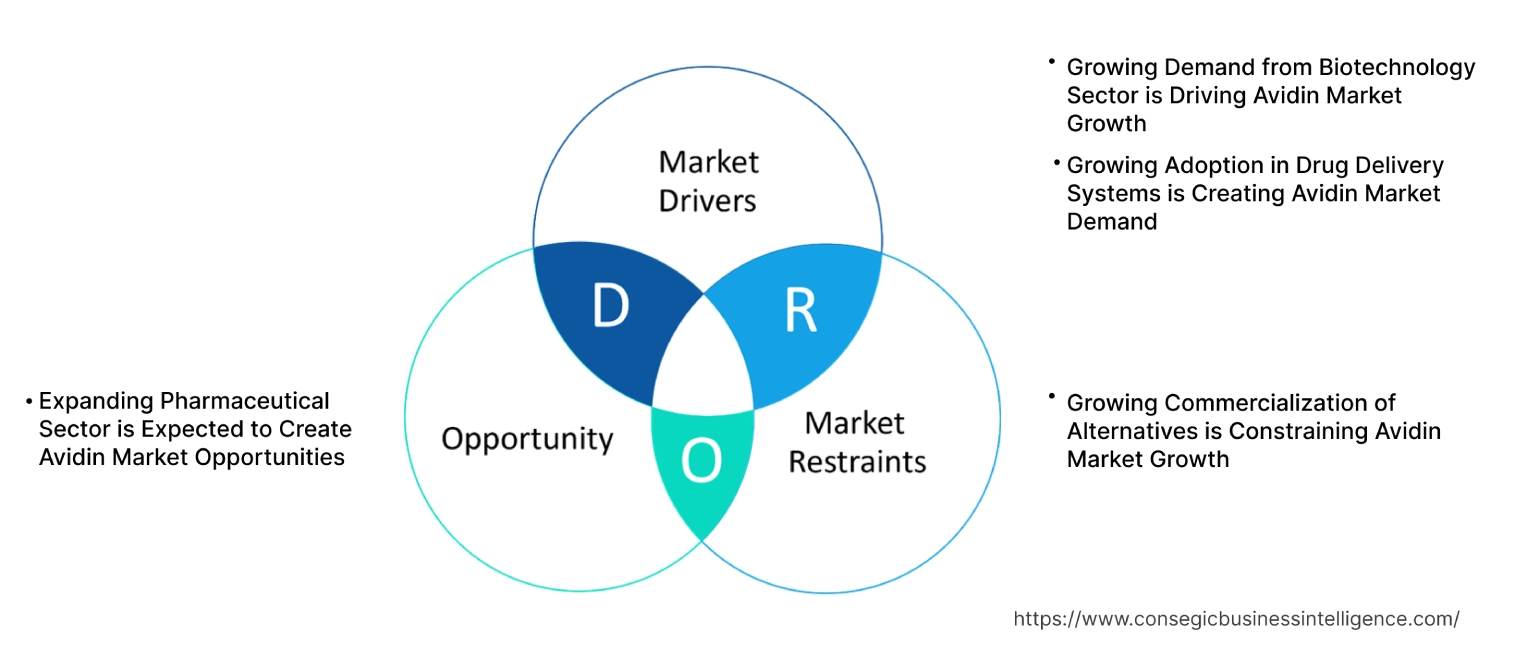- Summary
- Table Of Content
- Methodology
Avidin Market Size:
The avidin market size is growing with a CAGR of 6.0% during the forecast period (2025-2032), and the market is projected to be valued at USD 241.08 Million by 2032 from USD 151.88 Million in 2024. Additionally, the market value for 2025 is attributed to USD 160.44 Million.
Avidin Market Scope & Overview:
Avidin is a basic tetrameric glycoprotein produced in the oviducts of birds, reptiles and amphibians and deposited in the whites of their eggs. It has a molecular weight of around 67 kilodalton and is composed of four identical subunits. Its primary function is to bind to biotin with high affinity. It is available in both natural and recombinant types.Due to high stability and high affinity interaction with biotin, it is used in various applications such as biochemical assays, protein purification, nano biotechnology, drug delivery system, and others. This glycoprotein is used in various end-use sectors such as biotechnology, pharmaceutical, diagnostics, and others.Moreover, this glycoprotein is distributed through direct and indirect sales channels to drug manufacturers, biotechnology companies, and academic research institutes.
Key Drivers:
Growing Demand from Biotechnology Sector is Driving Avidin Market Growth
The biotechnology sector uses living organisms, cells, and biological processes to develop products and technologies. In this sector, avidin is used in protein engineering to prevent the degradation of therapeutic proteins. It is also utilized in bispecific antibody technology to enhance immune system activation against diseases. Additionally, investment in biotechnology sector is growing due to increasing need for new medications and government policies, furthermore driving the market.
- According to European Commission, European Innovation Council invested USD 378 Million in biotechnology sector in Europe in 2024. This growing investment is enhancing the protein engineering process which is furthermore driving the use of avidin for the prevention of therapeutic proteins degradation.
Hence, growing demand from the biotechnology sector is leading to avidin market expansion.
Growing Adoption in Drug Delivery Systems is Creating Avidin Market Demand
A drug delivery system is defined as a formulation or a device that enables the introduction of the therapeutically active substance in the body. In this system, avidin is used to incorporate drugs or other therapeutic agents to nanoparticles, allowing for targeted delivery to specific cells or tissues. It is also utilized for vector treating diseases such as cancer, genetic disorders, and infections. Moreover, companies are investing in drug delivery system advancements in technology and the rise of personalized medicine which is driving the market.
- In 2024, PCI Pharma Services invested 365 million to advance their drug delivery systems. This investment is leading to more efficient drug delivery systems which is driving the use of avidin for targeted drug delivery to specific cells or tissues.
Hence, growing adoption in drug delivery systems is creating avidin market demand.
Key Restraints:
Growing Commercialization of Alternatives is Constraining Avidin Market Growth
The commercialization of alternative glycoproteins such as streptavidin and NeutrAvidin amongst others is growing. They provide similar functions to that of avidin. Streptavidin is widely used in protein purification and nano biotechnology due to its lower production costs and higher specificity. Furthermore, NeutrAvidin is preferred in drug delivery systems due to less background staining and a near-neutral isoelectric point. Additionally, synthetic alternatives such as biotin-binding nanobodies and biotin receptors are used in biochemical assays due to low production cost and improved assay performance. Hence, the growing commercialization of alternatives is constraining the market demand due to low production costs and higher specificity.
Future Opportunities :
Expanding Pharmaceutical Sector is Expected to Create Avidin Market Opportunities
In the pharmaceutical sector, the avidin is used for vaccine development for antigen presentation, improving vaccine efficacy. It is also utilized for the synthesis of multi-arm nano-constructs, providing multiple sites for drug conjugation and targeting. Moreover, the pharmaceutical sector is growing significantly driven by rising lifestyle diseases, an aging population, and government support.
- According to India Briefing, the pharmaceutical sector in India is expected to grow with a compound annual growth rate of 17% by 2030 from 2025. This will lead to increase in vaccine development, in turn creating market opportunities to improve vaccine efficacy.
Hence, expanding pharmaceutical sector is expected to create avidin market opportunities.
Avidin Market Segmental Analysis :
By Type:
Based on Type, the market is categorized into natural and recombinant.
Trends in Type
- According to avidin market trends, natural type is widely used in protein purification for isolation of biotinylated proteins.
- Adoption of recombinant type is growing in non-radioactive detection system as per market trends.
The natural segment accounted for the largest market share in the year 2024.
- Natural avidin types are found in white egg portion of birds, reptiles, and amphibians.
- It is used in protein purification to enable the isolation of biotinylated proteins through affinity chromatography.
- Furthermore, the need for protein purification is growing due to the increasing adoption of protein-based therapeutics and advancements in proteomics research. To cater for this companies are investing in protein purification technology.
- For instance, in 2024, Syncell invested 15 Million to expand its protein purification technology. This investment in protein purification is driving the use of natural type for the isolation of biotinylated proteins.
- Hence, as investment in protein purification is growing, the need for natural type is also increasing, in turn driving the segment.
The recombinant segment is expected to grow at the fastest CAGR over the forecast period.
- Recombinant avidin type is produced using recombinant DNA technology, typically in bacteria or other cells.
- It is highly purified with high consistency, which is crucial for many research and diagnostic applications such as affinity-based separations and protein labeling.
- It is also utilized in non-radioactive detection systems to enable the visualization and quantification of biomolecules.
- Furthermore, the need for non-radioactive detection system is growing due to technological advancements and increased awareness of health hazards from radiation exposure. To cater this, manufacturers are incorporating recombinant type in their non-radioactive detection system for the visualization of biomolecules.
- Hence, as the need for non-radioactive detection system is growing, the demand for this type is also increasing. This will drive the segment for the forecasted years.
By Application:
Based on Application, the market is categorized into biochemical assays, protein purification, nano biotechnology, drug delivery system, and others.
Trends in Application
- As per avidin market trends, this glycoprotein is widely used in biochemical assays to detect and quantify proteins and antibodies.
- Adoption of avidin is growing in drug delivery system to enhance drug delivery efficiency as per market trends.
The biochemical assays segment accounted for the largest market share in the year 2024.
- A biochemical assay is an analytical procedure used to detect, quantify or study the binding or activity of enzymes or proteins.
- The avidin is widely used in biochemical assays, including ELISA (Enzyme-Linked Immunosorbent Assay), western blotting, and immunohistochemistry to detect and quantify proteins, antibodies, and other biomolecules.
- The demand for ELISA is growing due to its high sensitivity and specificity, ease of use, and ability to detect a wide range of antigens and antibodies. To cater for this, companies are investing in enzyme-linked immunosorbent assay against various antibodies.
- For instance, in 2022, J Mitra launchedHCV Gen 4 enzyme-linked immunosorbent assay. It uses avidin glycoprotein for detecting antibodies against HCV, furthermore, driving the market.
- Hence, as the adoption of enzyme-linked immunosorbent assay is growing, the need for this glycoprotein is also increasing, in turn driving the segment.
The drug delivery system segment is expected to grow at the fastest CAGR over the forecast period.
- In this drug delivery system, avidin glycoprotein is used to target specific locations which enhances drug delivery efficiency.
- It also helps to release drugs in a controlled manner at the target site, furthermore, reducing side effects of the drugs.
- Furthermore, the need for efficient drug delivery system is rising due to the high prevalence of chronic diseases and growing focus on patient-centric care. To cater, pharmaceutical companies are incorporating this glycoprotein to enhance their drug delivery efficiency.
- Hence, as the need for efficient drug delivery system is growing, the need for this glycoprotein is also increasing. This will drive the segment for the forecasted years.
By End-Use:
Based on End-Use, the market is categorized into biotechnology, pharmaceutical, diagnostics, and others.
Trends in End-Use
- The avidin is extensively used in the biotechnology sector for the development of advanced biosensors.
- Adoption of avidin is growing in sustained-release drug formulations to control the release of growth factors.
The biotechnology segment accounted for the largest market share of 46.78% in the year 2024.
- In the biotechnology sector, avidin glycoprotein is used in the protein and nucleic acid purification for various industrial and research processes.
- In addition to this, it is also utilized in biosensors to attach biomolecules onto microfluidic chips.
- The need for biosensors is growing due to the need for rapid and accurate diagnostics along with technological advancements. To cater for this, companies are investing in the biosensor’s development.
- For instance, in 2024, Dexcom partnered with ŌURA to enhance their biosensors for the metabolic health. This is driving the avidin market due to use for attachment of biomolecules onto microfluidic chips.
- Hence, as the need for efficient biosensors is growing, the need for this glycoprotein is also increasing, in turn driving the segment.
The pharmaceutical segment is expected to grow at the fastest CAGR over the forecast period.
- In the pharmaceutical sector, the avidin glycoprotein is used in enzyme therapy and biocatalysis to stabilize enzymes.
- It is also utilized in sustained-release drug formulations to control the release of insulin, growth factors, and fertility hormones.
- Furthermore, the adoption of sustained-release drug formulations is growing due to less frequency of administration, reduced side effects, and good patient compliance. To cater for this, pharmaceutical companies are incorporating avidin glycoprotein in these formulations to control the release of growth factors.
- Hence, as adoption of sustained-release drug formulations is growing, the need for this glycoprotein is also increasing. This will drive the segment for the forecasted years.
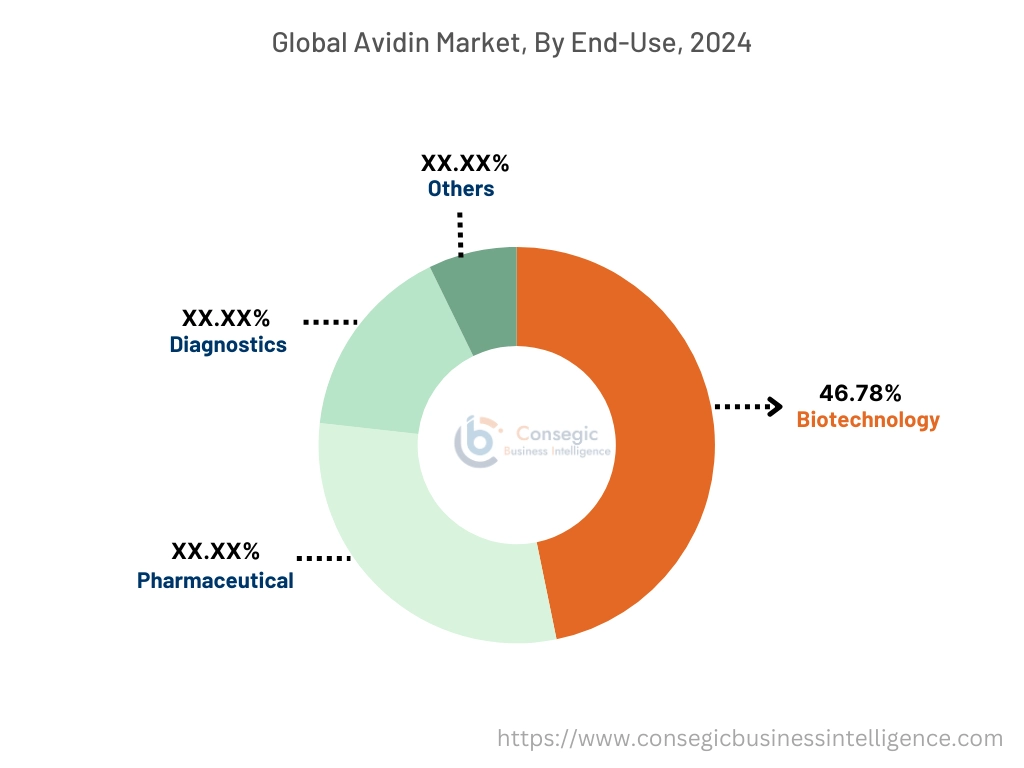
By Sales Channel:
Based on sales channel, the market is categorized into direct sales and indirect sales.
Trends in Sales Channel
- Direct sales channel ensures bulk and consistent product supply to drug manufacturers, biotechnology companies, and academic research institutes.
- Adoption of indirect sales channel is growing due to easy shopping experience and expansion of digital media as per market trends.
The direct sales segment accounted for the largest market share in the year 2024.
- Direct sales is a type of sales channel where products are sold directly to customers without any intermediaries.
- Avidin glycoprotein is widely sold through direct sales to drug manufacturers, biotechnology companies, and academic research institutes. They prefer direct procurement to ensure steady supply and lower costs.
- These sales channels also lead to higher margins and better control over the brand image.
- Additionally, the focus on building strong customer relationships and customer satisfaction is growing. This leads to an increase in direct sales of this glycoprotein to ensure a consistent supply.
- Hence, as focus on building customer relationships is growing, direct sales are also expanding, in turn driving the segment.
The indirect sales segment is expected to grow at the fastest CAGR over the forecast period.
- Indirect sales is a type of sales channel where products are sold through intermediaries such as distributors, retailers or agencies.
- It furthermore includes retail sales and online sales where avidin is sold through retailers or through online marketplaces to drug manufacturers, diagnostic laboratories, and pharmaceutical companies.
- Moreover, online sales offer advantages such as convenience, wider product selection, and personalized shopping experience. This is leading to more online sales in countries.
- For instance, according to Global Times, the online sales in China is increased by 11% in 2023 as compared to the year 2022. This includes avidin which is distributed through online marketplaces to drug manufacturers, diagnostic laboratories, and pharmaceutical companies.
- Thus, as the preference for wider product selection is growing, the adoption of online sales is also increasing. This will drive the segment for the forecasted years.
Regional Analysis:
The regions covered are North America, Europe, Asia Pacific, the Middle East and Africa, and Latin America.
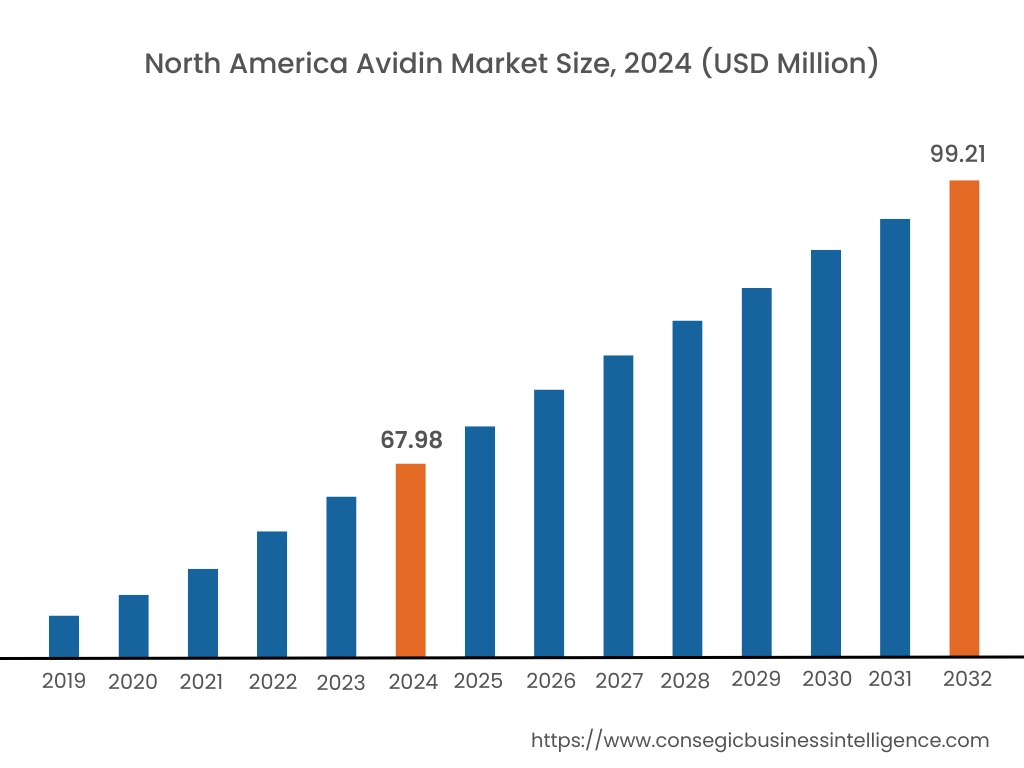
In 2024, North America accounted for the highest avidin market share at 44.77% and was valued at USD 67.98 Million and is expected to reach USD 99.21 Million in 2032. In North America, United States accounted for the highest avidin market share of 73.82% during the base year of 2024. As per analysis, North America holds a dominant position in the market due to expanding biotechnology sector. In this sector, avidin is used to enhance the sensitivity in Southern and Northern blotting in gene analysis. It is blood purification systems for removing biotinylated toxins or cytokines. Moreover, countries such as United States and Canada are major contributors in the region due to significant investment in biotechnology sector.
- In 2022, according to The Science Advisory Board, the government invested USD 2 Billion in biotechnology sector. This investment is leading to more development of blood purification systems thereby driving an avidin market supported by cytokines removal.
Therefore, due to the above-mentioned factors, the North America region is dominating in the market as per analysis.
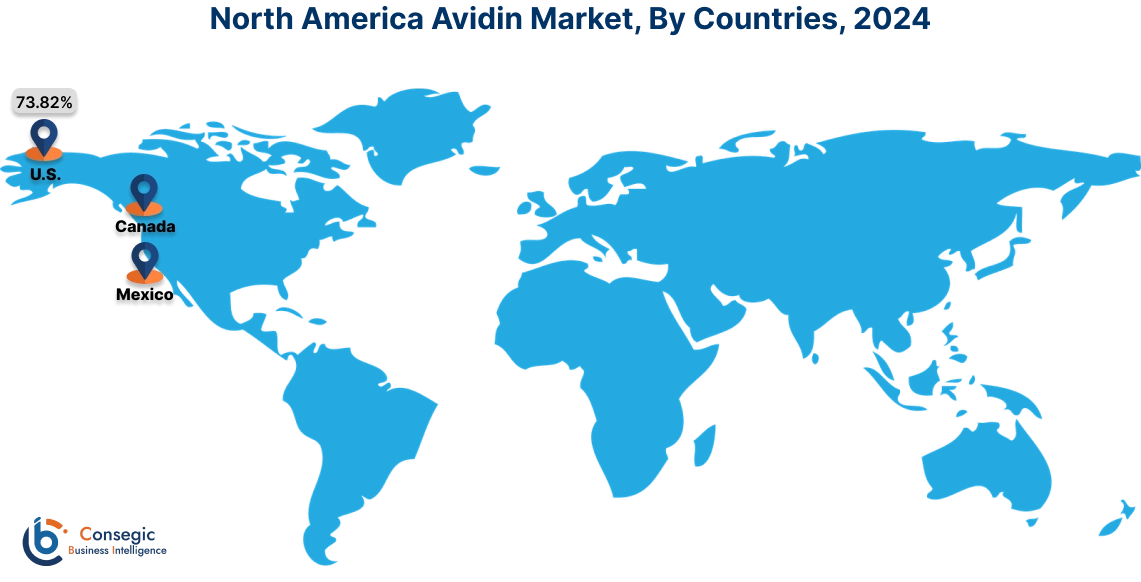
Asia Pacific is expected to witness the fastest CAGR of 8.2% over the forecast period of 2025-2032. According to avidin market analysis, the Asia Pacific region is growing rapidly driven by advancements in technology. Advancement in purification techniques and affinity chromatography have enhanced the performance, cost-effectiveness and sustainability in avidin market. Countries such as China, India, Japan, and South Korea are major contributors in the market due to adoption of genetic engineering and automation in manufacturing. These are increasing operational efficiency and ensuring high quality glycoprotein for various applications such as biochemical assays and drug delivery system. Hence, Asia Pacific is expected to emerge rapidly in the market through technological advancements as per analysis.
According to avidin market analysis, Europe region is experiencing considerable growth in the market driven by presence of stringent regulatory bodies and strong biopharmaceutical industry. The regulatory agencies such as European Medicines Agency are incorporating avidin to ensure the safety, quality, and efficacy of biosensors, biologics, and vaccines. Additionally, the growing focus on personalized medicine and investments in new vaccine development is furthermore driving the market in the region.
The Middle East and Africa regions are experiencing gradual growth in the market, driven by increasing investments in diagnosis services. The diagnostic laboratories in countries such as South Africa, UAE and Saudi Arabia are incorporating avidin in genetic testing to improve RNA or DNA detection sensitivity. It is also used in allergy diagnostics to detect immunoglobulin response to specific response to food, pollen, or drugs.
As per market analysis, the market in Latin America is driven by expanding pharmaceutical industry. In this, avidin is used in monoclonal antibodies and recombinant proteins to enhance their shelf life. It is also used in the treatment of genetic disorders to deliver biotinylated mRNA or DNA therapeutics. In countries such as Brazil and Argentina, investment in pharmaceutical sectors and research facilities is expanding. This is leading to avidin market expansion across the region.
Top Key Players and Market Share Insights:
The avidin industry is highly competitive with major players providing products to the national and international markets. Key players are adopting several strategies in research and development (R&D) and product innovation to hold a strong position in the global avidin market. Key players in the avidin industry include-
- e-Proteins (Belgium)
- Thermo Fisher Scientific Inc. (United States)
- Merck KGaA (Germany)
- Bio-Rad Laboratories, Inc. (United States)
- Agilent Technologies, Inc. (United States)
- Vector Laboratories, Inc. (United States)
- Aviva Systems Biology Corporation (United States)
- Bioseutica (Switzerland)
- Cell Signaling Technology, Inc. (United States)
- Avidity LLC (United States)
Avidin Market Report Insights :
| Report Attributes | Report Details |
| Study Timeline | 2019-2032 |
| Market Size in 2032 | USD 241.08 Million |
| CAGR (2025-2032) | 6.0% |
| By Type |
|
| By Application |
|
| By End-Use |
|
| By Sales Channel |
|
| By Region |
|
| Key Players |
|
| North America | U.S. Canada Mexico |
| Europe | U.K. Germany France Spain Italy Russia Benelux Rest of Europe |
| APAC | China South Korea Japan India Australia ASEAN Rest of Asia-Pacific |
| Middle East and Africa | GCC Turkey South Africa Rest of MEA |
| LATAM | Brazil Argentina Chile Rest of LATAM |
| Report Coverage |
|
Key Questions Answered in the Report
How big is the avidin market? +
In 2024, the avidin market is USD 151.88 Million.
Which is the fastest-growing region in the avidin market? +
Asia-Pacific is the fastest-growing region in the avidin market.
What specific segmentation details are covered in the avidin market? +
Type, Application, End-Use and Sales Channel are covered in the avidin market.
Who are the major players in the avidin market? +
e-Proteins (Belgium), Thermo Fisher Scientific Inc. (United States), and Merck KGaA (Germany) are some of the major players in the market.
